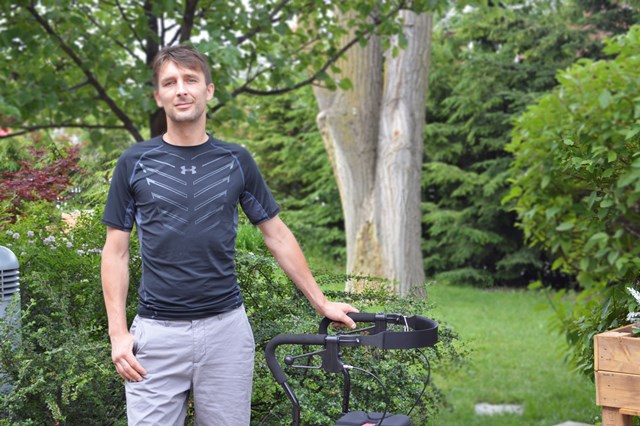
By Michael Oreskovich
Robert Tatarek is a man on the move. A general contractor who loves biking, snowboarding and being outdoors, the 36-year-old works hard and plays hard. His active lifestyle took an unexpected turn when he was hit by a car and ended up in acute care. Fortunately, Runnymede Healthcare Centre’s Active Rehab program was there to put Robert on a speedy path to recovery.
The accident happened while Robert was riding his bike in Toronto. After being struck by a car he was thrown from his bike and landed on a curb with a badly broken leg. Robert was taken into surgery in a nearby acute care hospital where a pin was inserted in his femur.
After the surgery, he was confined to a wheelchair, something Robert wasn’t used to. “I’m the kind of person who can’t sit still for five minutes,” he said. “This wasn’t something I ever expected to happen to me.”
Robert couldn’t resume his life in the community after his stay in acute care. He needed treatment to build up his strength so he could safely return home, and the acute care hospital referred him to Runnymede’s Active Rehab program.
Designed to support patients who can tolerate fast and intensive therapy, typically after injury or surgery, Active Rehab helps patients move out of acute care to receive timely access to treatment. The program enables patients to regain their abilities and provides them with the skills and understanding they need to return to the community when ready.
When Robert arrived at Runnymede, he experienced severe pain and couldn’t stand or move independently. Although he was optimistic, he admitted to feeling anxious about the recovery journey ahead of him.
“The main thing I thought about was how long it would take before I could get better,” he said. “Knowing there was a whole team here dedicated to getting me back to how I was before my injury made me feel very welcome and supported.”
The most important goal for Robert was to restore his strength and balance so he could get out of his wheelchair. The exercises the physiotherapists guided him through helped with this and increased the range of motion in his leg.
Robert also had to learn to adapt to new limitations that accompanied his injury. Runnymede’s occupational therapy team helped him modify his everyday tasks so he could safely get out of bed, wash himself and get dressed on his own. The team also arranged for some modifications at home so he could use his washroom independently.
“Every day I could see progress, and as I got stronger and stronger I was inspired to push myself even harder with the exercises the physiotherapists gave me,” Robert said. “The occupational therapists helped me get ready to get back into my daily routine back home.”
Within five days of his admission, Robert met all of his treatment goals and was ready for discharge. He no longer needed support from others to move, could stand on his own two feet and was able to get around with the support of a walker.
What’s next for Robert? He’s excited to get home and start back at work, but he knows there’s still some work ahead of him. “After I leave Runnymede, it’s up to me to finish my recovery,” he said. “The team here has taught me a lot about how to maintain my strength and I’m very confident about going back home.”
Michael Oreskovich is a communications specialistat Runnymede Healthcare Centre.

